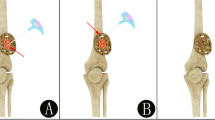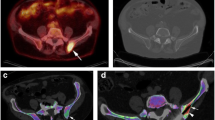Abstract
Purpose
In a minority of cases a definite diagnosis and stage grouping in cancer patients is not possible based on the imaging information of PET/CT. We report our experience with percutaneous PET/CT-guided bone biopsies to histologically verify the aetiology of hypermetabolic bone lesions.
Methods
We retrospectively reviewed the data of 20 consecutive patients who underwent multimodal image-guided bone biopsies using a dedicated PET/CT system in a step-by-step technique. Technical and clinical success rates of PET/CT-guided biopsies were evaluated. Questionnaires were sent to the referring physicians to assess the impact of biopsies on patient management and to check the clinical need for PET/CT-guided biopsies.
Results
Clinical indications for biopsy were to histologically verify the aetiology of metabolically active bone lesions without a morphological correlate confirming the suspicion of metastases in 15 patients, to determine the origin of suspected metastases in 3 patients and to evaluate the appropriateness of targeted therapy options in 2 patients. Biopsies were technically successful in all patients. In 19 of 20 patients a definite histological diagnosis was possible. No complications or adverse effects occurred. The result of PET/CT-guided bone biopsies determined a change of the planned treatment in overall 56% of patients, with intramodality changes, e.g. chemotherapy with palliative instead of curative intent, and intermodality changes, e.g. systemic therapy instead of surgery, in 22 and 50%, respectively.
Conclusion
PET/CT-guided bone biopsies are a promising alternative to conventional techniques to make metabolically active bone lesions—especially without a distinctive morphological correlate—accessible for histological verification. PET/CT-guided biopsies had a major clinical impact in patients who otherwise cannot be reliably stage grouped at the time of treatment decisions.




Similar content being viewed by others
References
Subedi N, Scarsbrook A, Darby M, Korde K, Mc Shane P, Muers MF. The clinical impact of integrated FDG PET-CT on management decisions in patients with lung cancer. Lung Cancer 2009;64:301–7. doi:10.1016/j.lungcan.2008.09.006.
Lardinois D, Weder W, Hany TF, Kamel EM, Korom S, Seifert B, et al. Staging of non-small-cell lung cancer with integrated positron-emission tomography and computed tomography. N Engl J Med 2003;348:2500–7. doi:10.1056/NEJMoa022136 348/25/2500.
Naumann R, Beuthien-Baumann B, Reiss A, Schulze J, Hänel A, Bredow J, et al. Substantial impact of FDG PET imaging on the therapy decision in patients with early-stage Hodgkin’s lymphoma. Br J Cancer 2004;90:620–5. doi:10.1038/sj.bjc.6601561 6601561.
Allen-Auerbach M, de Vos S, Czernin J. The impact of fluorodeoxyglucose-positron emission tomography in primary staging and patient management in lymphoma patients. Radiol Clin North Am 2008;46:199–211. doi:10.1016/j.rcl.2008.03.004. vii.
Groheux D, Moretti JL, Baillet G, Espie M, Giacchetti S, Hindie E, et al. Effect of (18)F-FDG PET/CT imaging in patients with clinical stage II and III breast cancer. Int J Radiat Oncol Biol Phys 2008;71:695–704. doi:10.1016/j.ijrobp.2008.02.056.
Klaeser B, Wiederkehr O, Koeberle D, Mueller A, Bubeck B, Thuerlimann B. Therapeutic impact of 2-[fluorine-18]fluoro-2-deoxy-D-glucose positron emission tomography in the pre- and postoperative staging of patients with clinically intermediate or high-risk breast cancer. Ann Oncol 2007;18:1329–34. doi:10.1093/annonc/mdm139.
Borrego Dorado I, Vázquez Albertino R, López Martín J, Alvarez Pérez RM. Evaluation of efficacy and clinical impact of FDG-PET on patients with suspicion of recurrent cutaneous melanoma. Rev Esp Med Nucl 2006;25:301–11. 13092697.
Bastiaannet E, Wobbes T, Hoekstra OS, van der Jagt EJ, Brouwers AH, Koelemij R, et al. Prospective comparison of [18F]fluorodeoxyglucose positron emission tomography and computed tomography in patients with melanoma with palpable lymph node metastases: diagnostic accuracy and impact on treatment. J Clin Oncol 2009;27:4774–80. doi:10.1200/JCO.2008.20.1822.
Huch K, Röderer G, Ulmar B, Reichel H. CT-guided interventions in orthopedics. Arch Orthop Trauma Surg 2007;127:677–83. doi:10.1007/s00402-007-0410-z.
Lis E, Bilsky MH, Pisinski L, Boland P, Healey JH, O’Malley B, et al. Percutaneous CT-guided biopsy of osseous lesion of the spine in patients with known or suspected malignancy. AJNR Am J Neuroradiol 2004;25:1583–8. 25/9/1583.
Klaeser B, Mueller MD, Schmid RA, Guevara C, Krause T, Wiskirchen J. PET-CT-guided interventions in the management of FDG-positive lesions in patients suffering from solid malignancies: initial experiences. Eur Radiol 2009;19:1780–5. doi:10.1007/s00330-009-1338-1.
Czernin J, Allen-Auerbach M, Schelbert HR. Improvements in cancer staging with PET/CT: literature-based evidence as of September 2006. J Nucl Med 2007;48 Suppl 1:78S–88. 48/1_suppl/78S.
Poeppel TD, Krause BJ, Heusner TA, Boy C, Bockisch A, Antoch G. PET/CT for the staging and follow-up of patients with malignancies. Eur J Radiol 2009;70:382–92. doi:10.1016/j.ejrad.2009.03.051.
Park JY, Kim EN, Kim DY, Suh DS, Kim JH, Kim YM, et al. Role of PET or PET/CT in the post-therapy surveillance of uterine sarcoma. Gynecol Oncol 2008;109:255–62. doi:10.1016/j.ygyno.2008.01.030.
Kitajima K, Murakami K, Yamasaki E, Kaji Y, Fukasawa I, Inaba N, et al. Diagnostic accuracy of integrated FDG-PET/contrast-enhanced CT in staging ovarian cancer: comparison with enhanced CT. Eur J Nucl Med Mol Imaging 2008;35:1912–20. doi:10.1007/s00259-008-0890-2.
Aoki J, Watanabe H, Shinozaki T, Takagishi K, Ishijima H, Oya N, et al. FDG PET of primary benign and malignant bone tumors: standardized uptake value in 52 lesions. Radiology 2001;219:774–7.
Charest M, Singnurkar A, Hickeson M, Novales JA, Derbekyan V. Intensity of FDG uptake is not everything: synchronous liposarcoma and fibrous dysplasia in the same patient on FDG PET-CT imaging. Clin Nucl Med 2008;33:455–8. doi:10.1097/RLU.0b013e31817793bb 00003072-200807000-00001.
Strobel K, Bode B, Lardinois D, Exner U. PET-positive fibrous dysplasia—a potentially misleading incidental finding in a patient with intimal sarcoma of the pulmonary artery. Skeletal Radiol 2007;36 Suppl 1:S24–8. doi:10.1007/s00256-006-0152-y.
Stegger L, Juergens KU, Kliesch S, Wormanns D, Weckesser M. Unexpected finding of elevated glucose uptake in fibrous dysplasia mimicking malignancy: contradicting metabolism and morphology in combined PET/CT. Eur Radiol 2007;17:1784–6. doi:10.1007/s00330-006-0466-0.
Mahmood S, Martinez de Llano SR. Paget disease of the humerus mimicking metastatic disease in a patient with metastatic malignant mesothelioma on whole body F-18 FDG PET/CT. Clin Nucl Med 2008;33:510–2. doi:10.1097/RLU.0b013e318177928a 00003072-200807000-00019.
Ludwig V, Fordice S, Lamar R, Martin WH, Delbeke D. Unsuspected skeletal sarcoidosis mimicking metastatic disease on FDG positron emission tomography and bone scintigraphy. Clin Nucl Med 2003;28:176–9. doi:10.1097/01.RLU.0000053528.35645.70.
Strobel K, Exner UE, Stumpe KD, Hany TF, Bode B, Mende K, et al. The additional value of CT images interpretation in the differential diagnosis of benign vs. malignant primary bone lesions with 18F-FDG-PET/CT. Eur J Nucl Med Mol Imaging 2008;35:2000–8. doi:10.1007/s00259-008-0876-0.
Metser U, Miller E, Lerman H, Even-Sapir E. Benign nonphysiologic lesions with increased 18F-FDG uptake on PET/CT: characterization and incidence. AJR Am J Roentgenol 2007;189:1203–10. doi:10.2214/AJR.07.2083.
Buhmann Kirchhoff S, Becker C, Duerr HR, Reiser M, Baur-Melnyk A. Detection of osseous metastases of the spine: comparison of high resolution multi-detector-CT with MRI. Eur J Radiol 2009;69:567–73. doi:10.1016/j.ejrad.2007.11.039.
Heusner T, Gölitz P, Hamami M, Eberhardt W, Esser S, Forsting M, et al. “One-stop-shop” staging: should we prefer FDG-PET/CT or MRI for the detection of bone metastases? Eur J Radiol 2009. doi:10.1016/j.ejrad.2009.10.031.
Ishimori T, Patel PV, Wahl RL. Detection of unexpected additional primary malignancies with PET/CT. J Nucl Med 2005;46:752–7. 46/5/752.
van Westreenen HL, Westerterp M, Jager PL, van Dullemen HM, Sloof GW, Comans EF, et al. Synchronous primary neoplasms detected on 18F-FDG PET in staging of patients with esophageal cancer. J Nucl Med 2005;46:1321–5. 46/8/1321.
Wang G, Lau EW, Shakher R, Rischin D, Ware RE, Hong E, et al. How do oncologists deal with incidental abnormalities on whole-body fluorine-18 fluorodeoxyglucose PET/CT? Cancer 2007;109:117–24. doi:10.1002/cncr.22370.
Acknowledgements
B.K., J.W. and T.K. were supported by a local quality assurance project.
Conflicts of interest
None.
Author information
Authors and Affiliations
Corresponding author
Rights and permissions
About this article
Cite this article
Klaeser, B., Wiskirchen, J., Wartenberg, J. et al. PET/CT-guided biopsies of metabolically active bone lesions: applications and clinical impact. Eur J Nucl Med Mol Imaging 37, 2027–2036 (2010). https://doi.org/10.1007/s00259-010-1524-z
Received:
Accepted:
Published:
Issue Date:
DOI: https://doi.org/10.1007/s00259-010-1524-z




